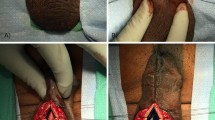Summary
The posterior prostatomembranous urethral stricture or distraction defect has historically been the most formidable challenge of stricture surgery. This uncommon lesion occurs most often as the sequelae of pelvic fracture injuries, or straddle trauma, and is associated with serious urethral disruption and separation – an injury that is often complicted by inappropriate initial management using substitution skin flap techniques with the development of recurrent stenosis, irreversible impotence, and occasional incontinence. Management by endoscopic techniques may be possible in patients with short strictures or in those after prostatectomy, but they rarely play a role in resolving the complex obliterated urethra with a significant defect [1]. Resolution of post-traumatic posterior urethral distraction defects and other posterior urethral pathologic conditions has dramatically improved over the past two decades despite an inaccessible subpublic location involving exposed sphincter-active and erectile neurovascular anatomy. The contemporary, perineal, one-stage bulboprostatic anastomotic operation as popularized by Turner-Warwick [20] with selective scar excision is a versatile procedure with a high patent lumen success. Patients undergoing anastomotic urethroplasty have a substained patent urethral lumen success rate approaching 100 % versus those who have undergone urethral skin flap or patch repair, where the restricture rate in 5 and 10 years increases twofold to threefold [1, 20]. A patent urethra after an anastomotic urethroplasty at 6 months is free from further recurrent stricture and gives credence to Mr. Turner-Warwick's admonition that “urethra is the best substitute for urethra”.
Zusammenfassung
In der Vergangenheit war die postmembranöse Striktur oder Distraktion der hinteren Urethra die größte Herausforderung der Stenosenchirurgie. Diese seltene Verletzung kommt häufig als Folge von Beckenfrakturen oder „Straddle“traumata vor und ist mit urethraler Unterbrechung und Trennung verbunden. Sie ist eine Verletzung, die häufig verkompliziert wird durch die initiale Versorgung mit inadäquaten Hautlappenersatztechniken, mit nachfolgender Entwicklung von Stenosen, irreversibler Impotenz und zeitweiliger Inkontinenz. Patienten mit kurzen Stenosen oder nach Prostatektomie können gelegentlich mit endoskopischer Technik versorgt werden, aber bei der komplex obliterierten Urethra mit einem signifikanten Defekt spielt die Endoskopie keine nennenswerte Rolle [1]. Trotz der unzugänglichen anatomischen Lage mit Exposition sphinkterer und neurovaskulärer Anteile haben sich die Lösungsansätze für die posttraumatischen hinteren Urethradistraktiondefekte und anderen pathologischen Verhältnisse der hinteren Urethra über die letzten 2 Jahrzehnte dramatisch verbessert. Die gleichzeitige, perineale, einzeitige bulboprostatische Anastomosenoperation wie von Turner-Warwick [20] favorisiert mit selektiver Narbenexzision ist eine vielseitige Prozedur mit großem Erfolg bezüglich des offenen Lumens. Patienten, die mit einer Anastomosenurethroplastik versorgt werden, haben im Gegensatz zu denen, die mit einem urethralen Hautlappen oder einem Patch versorgt wurden, eine Erfolgsrate des erhaltenen durchgängigen Lumens von fast 100 %. Bei letzteren Patienten ist die Restrikturrate nach 5 und 10 Jahren 2- bis 3 fach erhöht [1, 20]. Eine durchgängige Urethra 6 Monate nach einer Anastomosen Urethroplastik hat kein weiteres Rezidivrisiko und bestätigt Turner-Warwicks Aussage, daß„Urethra der beste Ersatz für Urethra ist“.
Similar content being viewed by others
Author information
Authors and Affiliations
Rights and permissions
About this article
Cite this article
Zinman, L. Posterior urethral reconstruction. Urologe 37, 31–37 (1998). https://doi.org/10.1007/s001200050145
Published:
Issue Date:
DOI: https://doi.org/10.1007/s001200050145




